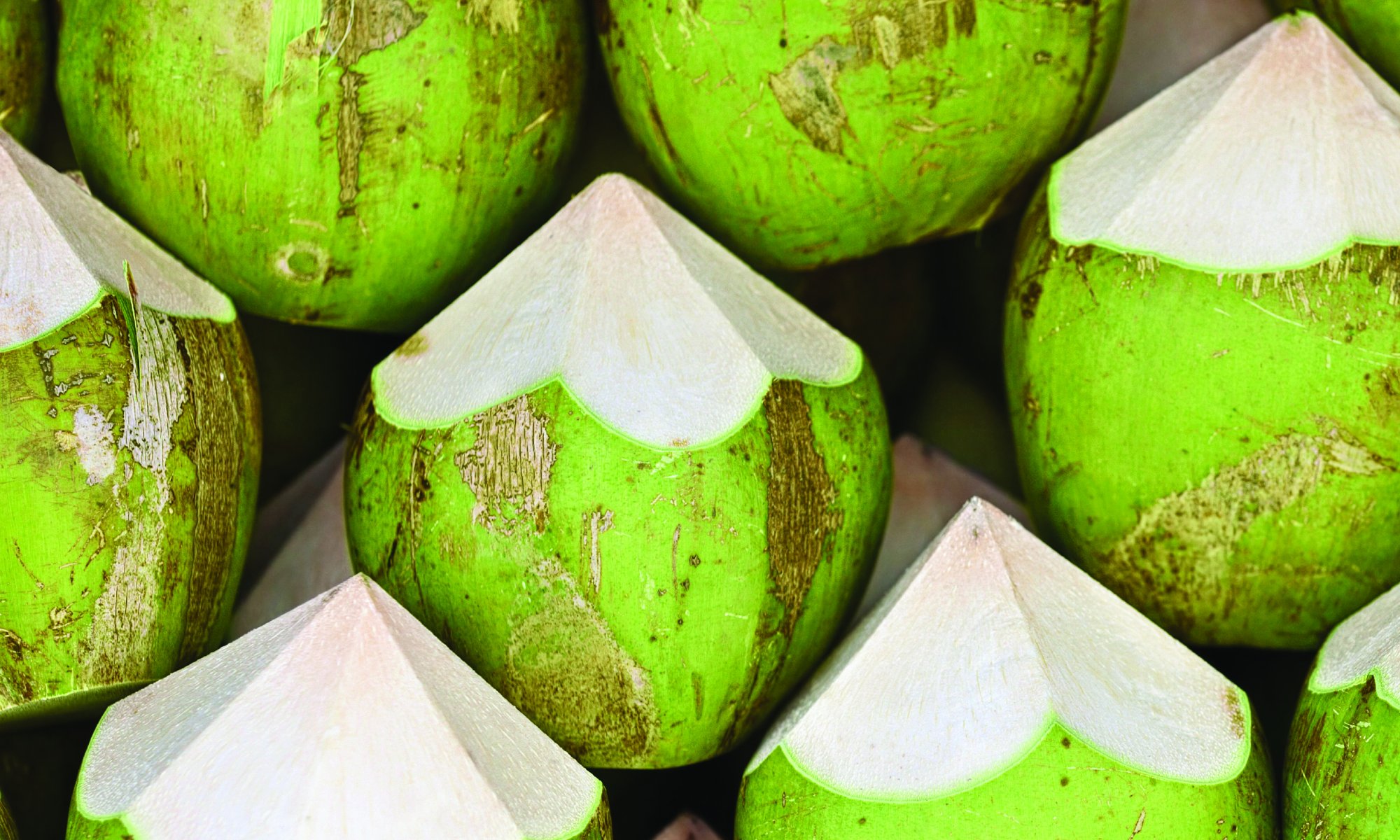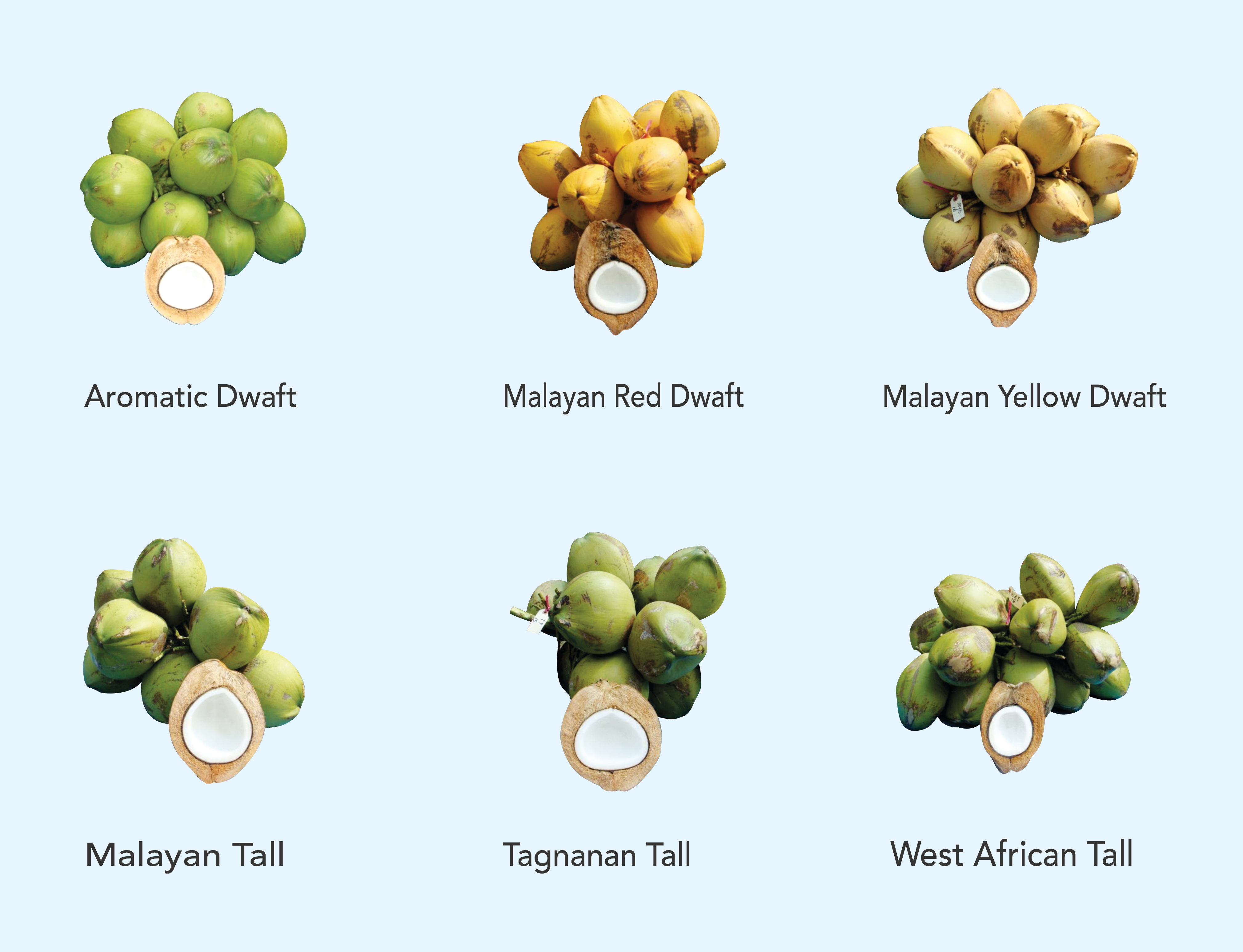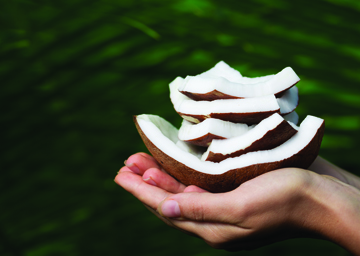Composition

The coconut’s composition is dependent on several factors such as age and varieties. This chapter gives a description of the chemical composition of the coconut, which will form a basis for understanding chemical processes in the following chapters.
Parts of the coconut
The coconut, scientifically known as cocos nucifera, is a fibrous drupe fruit (Figure 3.1). Usually ovoid in shape, it comes in various sizes and colour (Figure 3.2). In general, a coconut takes about 12 months to mature, weighing up to 1.2-2kg.
Life cycle of the coconut
Under ideal conditions, the coconut palm produces one leaf and one inflorescence, or better known as male and female flowers within a spathe, on a monthly basis. After the inflorescence opens and fertilization of the flowers take place, coconuts begin to form (Figure 3.3).
They start to grow in size, and the cavity inside the nut differentiates itself in the second month, reaching its maximum size by the seventh month, filled with coconut water. It is also during this time that a thin and soft layer of raw kernel forms. As the nuts ripen, its hardness and quantity increase at a declining rate. The thickness of the kernel also increases, while the internal cavity reduces in size. There is also a progressive decrease in the quantity of coconut water as the nut ripens. More details on the life cycle of the coconut are covered in Chapter 4.
Overall composition
In general, a new bunch of coconuts forms on a monthly basis. As they grow in size over a 12 month period, the volume composition of the coconut water and the weight of the kernel undergoes major changes.
After they ripen, unharvested coconuts left hanging on the trees will begin to germinate. This process depletes both the coconut water and kernel to facilitate root and shoot growth in a germinating coconut.
Composition of coconut water
Coconut water is the liquid endosperm found in the cavity of the nut. By the third month of fruit development, there are small quantities of coconut water. This amount increases and reaches the maximum when the nut is 7-9 months old. This is also when the coconut water tastes the sweetest and is classified as young coconut water.
Coconut water harvested from nuts between 10-13 months old is classified as mature coconut water. After the nuts ripen, the amount of coconut water declines. This is because during maturation, coconut water is used to form coconut flesh inside the fruit, a phenomenon across all of the coconut’s varieties.
Coconut water comprises of 95% water, with trace amounts of carbohydrates, proteins, oils, vitamins and minerals.
The chemical composition of Malayan Tall Coconuts is illustrated in Table 3.1.
Carbohydrates
Carbohydrates, otherwise known by the general chemical formula Cn(H2O)m, consist of monosaccharides and disaccharides (simple sugars), oligosaccharides and polysaccharides (complex carbohydrates such as starch, hemicellulose, cellulose and pectin).
Coconut water consists of carbohydrates, namely sucrose, glucose and fructose. These are primary sugars which contribute to the sweetness of the coconut water. As the coconut matures, more sucrose content can be found in coconut water. The reverse is observed for fructose and glucose when the coconut matures.
Proteins
Proteins, described as giant molecules made of amino acids, are an essential part of our diet. A protein molecule usually contains one or more interlinked chains of 100-200 amino acids, where they are arranged in a specific order. When the human body consumes proteins, they are broken down into simpler compounds in the digestive system and liver. These compounds are then transported to body cells, where they are used to construct and build the body’s own protein. Active proteins, better known as enzymes, control a large majority of these chemical reactions inside our bodies. They have the ability to trigger and affect the course and speed of such chemical reactions. Surprisingly, enzymes have the ability to do this without being consumed. Therefore, they are sometimes called biocatalysts.
Coconut water also contains a small amount of enzymes, which varies according to the coconut’s maturity. When packaging coconut water, it is important to manage these reactions so that the coconut water remains colourless, ensuring a quality product over time. In general, the measurement of enzyme content is based on their enzymatic activity. As the coconut matures, the enzymatic activity of peroxidase (POD) and polyphenol oxidase (PPO) decreases (Table 3.3).
Vitamins
Vitamins are organic substances occurring in very small concentrations. It consists of complex chemical compositions and is essential to normal life processes. However, vitamins cannot be synthesized by the body.
Coconut water contains water soluble vitamins. In particular, Vitamin C (ascorbic acid) and a range of Vitamin B, as shown in Table 3.4.
Minerals
Electrolytes are minerals which have an electric charge in our bodies. Many of our bodily functions are regulated by the amount of electrolytes present in the body to conduct electrical signals. These electrolytes are obtained by consuming food and drink. They are also lost through sweat and urine.
Acidity
Acidity refers to the concentration of hydrogen ions in a specific amount of liquid. This varies from one solution to another. The pH symbol is used to denote the hydrogen ion concentration. Mathematically, pH is defined as the negative logarithm to the base 10 of the hydrogen ion concentration expressed in molarity i.e. pH = -log[H+]. This results in the following scale at 25°C:
Acidity affects the flavour of coconut water. As the coconut matures, the pH of coconut water increases in alkaline levels. It becomes less acidic and, coupled with increasing sugar levels, coconut water tastes sweeter when it is seven to nine months old
Acidity also influences the thermal processing method required to package coconut water. With a pH value ranging from 4.9-5.5, coconut water is above the benchmarked pH value of 4.6. It is therefore considered a low-acid product, suitable for the growth of microorganisms. As such it is recommended that low acid products like coconut water undergo ultra-high temperature (UHT) thermal processing for a longer shelf life. This will be covered in greater detail in Chapter 11.
Phenolic content
Phenolic content contributes to the overall complex flavour profile of coconut water. Phenolic content of coconut water decreases with maturity. When oxidised, the polyphenols can also contribute to the colouration of coconut water.
Composition of coconut kernel
The composition of coconut kernel is commonly measured according to the percentage of oil in the kernel which is remarkably consistent across different coconut varieties. As the coconut matures, the growth of the shell cavity is almost complete before the endosperm (kernel) enters the rapid growth stage, which begins after eight months and lasts for about three months thereafter. During this stage, the amount of coconut kernel increases up to 44% of the dehusked nut’s weight (Table 3.5).
Raw kernel oil content
When a coconut matures, the weight and meat composition change rapidly. This is because the moisture content decreases to approximately 50% when coconuts reach 12-15 months old. On the other hand, the oil composition of a coconut increases as it advances through different stages of maturity. For comparison, a younger coconut between eight to nine months old has 18-26% oil content, whereas a mature nut can have up to 43% oil content on a wet basis. This shows that the amount of oil contained in the raw material is strongly dependent upon maturity.
In the initial stages of coconut fruit growth, the oil content of the kernel only increases by a small amount. However, when the coconut is nine months old, some raw kernel is developed, which can be turned into copra or coconut milk. By then, the oil content of the kernel would have increased drastically to approximately 25-30% on wet basis (50% moisture). The remaining percentage of raw kernel consists of carbohydrates, protein, fibre and ash.
As the coconut continues to mature, the oil content will further increase until it peaks at approximately 43%. Thereafter, the oil content decreases when the coconut germinates.
Table 3.6 shows that different coconuts vary in the levels of oil content at various coconut ages.
In most countries, coconuts are harvested at 10-13 months old. This is when high oil content can be used to produce copra, coconut milk, cream and related food products. There are two types of wet kernel – one where the testa (brown skin) is still attached to the white kernel, and another where the testa has been peeled off.
Copra
Raw kernel can be dried under the sun or using a kiln to produce dried kernel, otherwise known as copra cake. This is later processed into coconut oil. Copra cake contains 6% moisture levels, with oil content ranging from 60-65%. It also consists of 27% carbohydrates, 20% proteins, fibre and ash (Table 3.7).
Oil
At least 55% of dried kernel consists of oils like triglycerides, free fatty acids, phospholipids and unsaponifiables. It is one of the few fruits which stores a major portion of its energy source in medium chain triglycerides (MCTs) – an important source of energy for coconuts to germinate. Originating from a plant source, coconut oil is also cholesterol-free.
Triglycerides contain three free fatty acids and one alcohol called glycerol. Depending on the number of multiple bonds present in its chain, a fatty acid may be classified as saturated or unsaturated.
Saturated fatty acids comprise of exclusively single bonds between all carbons in their backbone. Unsaturated fatty acids have double bonds in their backbones, known as mono (if there is only one double bond), or poly (if there are multiple double bonds).
Coconut kernel contains 90% saturated fatty acids and 10% unsaturated fatty acids. These saturated fatty acids are mostly MCTs with a range of six to 12 carbon atoms in their chains. A significant proportion of these MCTs is made out of 12 carbon long lauric acid (C12) (Table 3.8).
Recent studies have shown that MCTs have many health benefits. They are metabolized differently from long-chain fatty acids. Similar to carbohydrates, they are more readily oxidized through the ß-oxidation pathway, and is therefore rapidly absorbed by the body. As a result, MCTs are also used as a supplement to enhance the fat burning process and improve the body composition of fat and lean tissue.
Oil content during coconut germination
Triglycerides in the coconut kernel primarily provides energy supply for the coconut to germinate and mature. Initially, the coconut uses its limited sources of sucrose as energy. When the carbohydrate store becomes exhausted after 60-90 days of germination, the growing haustorium, roots and shoots accumulate lipids rich in lauric acid (C12). This depletes the lauric acid supply in the coconut kernel.
Lauric acid is presumably used as an energy source to fuel biochemical activities for growth by generating carbon. It is important to note that such coconuts should not be used for copra or coconut milk production as the available oil content is lower when germination occurs.
Protein
Coconut kernel contains 5-10% of proteins on a wet matter basis. Coconut kernel has a mix of essential, non-essential and conditionally essential amino acids. USDA defines essential amino acids as those that have carbon skeletons which cannot be synthesized and must therefore be supplemented in the diet.
Conversely, non-essential amino acids can be synthesized from simpler precursors, often essential amino acids. There are also some conditionally essential amino acids which, under regular conditions, can be synthesized when the body feels relaxed. The classification of amino acids is shown in Table 3.9.
The breakdown of amino acids in coconut meal is shown in Table 3.10 below. In particular, arginine has cardio protective benefits.
Carbohydrates
Coconut kernel contains about 10-15% carbohydrates on a wet matter basis. This makes carbohydrates the second largest dry component in coconuts. However, carbohydrates are economically less important than coconut oil, as the kernel is mostly used to extract copra oil. The remaining dry matter is used as animal feed, and coconut flour is produced for human consumption.
Soluble Carbohydrates
Soluble carbohydrates comprise of monosaccharides, disaccharides, oligosaccharides (e.g. mannose, galactose, sucrose, raffinose, stachyose), and polysaccharides (e.g. galactomannan). In general, soluble carbohydrates decrease with the maturity of the coconut kernel.
Insoluble Carbohydrates
Insoluble carbohydrates include cellulose, hemicellulose, and lignin. These carbohydrates are mostly structural components of cell walls. These insoluble carbohydrates generally increase when the kernel thickens with maturity.
Vitamins
Mature coconut kernel contains both water and oil soluble vitamins. Table 3.11 shows the vitamin contents in coconut kernel.
Minerals
Coconut kernel contains 1-2% ash content on a wet matter basis. The major minerals present are potassium, calcium, magnesium, and sodium (Table 3.12).
Flavour compounds
Flavour compounds contribute to the overall flavour profile of coconut kernel and its derived products. It is a complex mixture of phytosterols and phenolic acids (Table 3.13).






